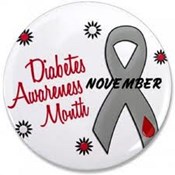In observance of National Diabetes Month, including World Diabetes Day on Nov. 14, the National Institutes of Health (NIH) urges people to take action and make simple but important lifestyle changes to achieve their health goals — whether they have diabetes or are at risk for the disease.
Nearly 26 million Americans have diabetes. In type 1 diabetes, the body does not make insulin. People with type 1 need to take daily insulin to live. In type 2 diabetes — the most common type, which has risen in incidences along with the obesity epidemic — the body does not make or use insulin well. People with type 2 may need to take pills or insulin to manage the disease. A third type, gestational diabetes, occurs in some women during pregnancy. It usually goes away after the birth, but these women and their children have a greater chance of getting type 2 diabetes later in life.
Left untreated, diabetes can lead to serious complications, such as heart disease, stroke, kidney disease, blindness and amputation. An estimated 79 million adults have prediabetes, a condition that places them at increased risk for developing type 2 diabetes and heart disease.
To find out your risk for type 2 diabetes, check each item that applies to you.
- I am age 45 or older.
- I am overweight or obese.
- I have a parent, brother, or sister with diabetes.
- My family background is African American, Alaska Native, American Indian, Asian American, Hispanic/Latino, or Pacific Islander American.
- I have had gestational diabetes.
- I gave birth to at least one baby weighing more than 9 pounds.
- My blood pressure is 140/90 or higher, or I have been told that I have high blood pressure.
- My cholesterol levels are higher than normal. My HDL, or good, cholesterol is below 35, or my triglyceride level is above 250.
- I am fairly inactive.
- I have polycystic ovary syndrome, also called PCOS.
- On previous testing, I had prediabetes—an A1C level of 5.7 to 6.4 percent, impaired fasting glucose (IFG), or impaired glucose tolerance (IGT).
- I have other clinical conditions associated with insulin resistance, such as a condition called acanthosis nigricans, characterized by a dark, velvety rash around my neck or armpits.
- I have a history of cardiovascular disease.
The more items you checked, the higher your risk.
You can do a lot to reduce your risk of getting type 2 diabetes. Being more physically active, reducing fat and calorie intake, and losing a little weight can help you lower your chances of developing type 2 diabetes. Even small changes — such as losing a small amount of weight and becoming more active — can go a long way toward preventing type 2 diabetes, as well as managing the disease.







